lights MITSUBISHI ECLIPSE CROSS 2019 (in English) Owner's Guide
[x] Cancel search | Manufacturer: MITSUBISHI, Model Year: 2019, Model line: ECLIPSE CROSS, Model: MITSUBISHI ECLIPSE CROSS 2019Pages: 423, PDF Size: 75.41 MB
Page 154 of 423
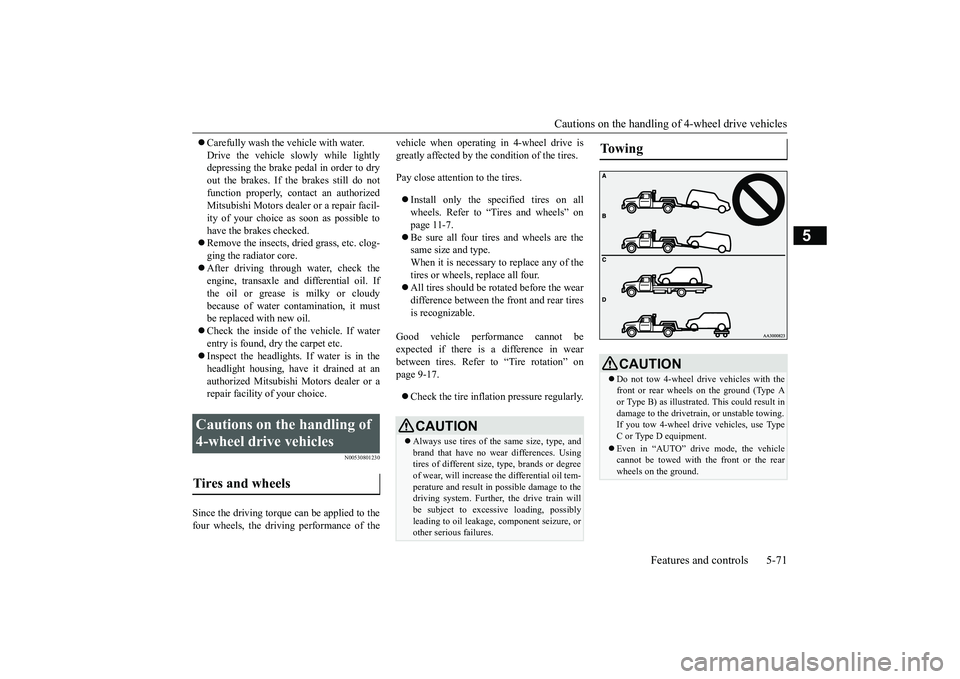
Cautions on the handling of 4-wheel drive vehicles
Features and controls 5-71
5
Carefully wash the vehicle with water. Drive the vehicle slowly while lightly depressing the brake pedal in order to dry out the brakes. If the brakes still do notfunction properly, co
ntact an authorized
Mitsubishi Motors dealer or a repair facil- ity of your choice as soon as possible tohave the brakes checked. Remove the insects, dried grass, etc. clog- ging the radiator core. After driving through water, check the engine, transaxle and differential oil. If the oil or grease is milky or cloudy because of water contamination, it mustbe replaced with new oil. Check the inside of the vehicle. If water entry is found, dry the carpet etc. Inspect the headlights. If water is in the headlight housing, have it drained at an authorized Mitsubishi Motors dealer or arepair facility of your choice.
N00530801230
Since the driving torque can be applied to thefour wheels, the driving performance of the
vehicle when operating in 4-wheel drive is greatly affected by the condition of the tires. Pay close attention to the tires. Install only the specified tires on all wheels. Refer to “Tires and wheels” on page 11-7. Be sure all four tires and wheels are the same size and type. When it is necessary to replace any of thetires or wheels, replace all four. All tires should be rotated before the wear difference between the front and rear tires is recognizable.
Good vehicle performance cannot be expected if there is a difference in wear between tires. Refer to “Tire rotation” on page 9-17. Check the tire inflation pressure regularly.
Cautions on the handling of 4-wheel drive vehicles Tires and wheels
CAUTION Always use tires of the same size, type, and brand that have no wear differences. Using tires of different size, type, brands or degree of wear, will increase the differential oil tem- perature and result in possible damage to thedriving system. Further, the drive train will be subject to excessive loading, possibly leading to oil leakage, component seizure, orother serious failures.
To w i n g
CAUTION Do not tow 4-wheel drive vehicles with the front or rear wheels on the ground (Type Aor Type B) as illustrated. This could result in damage to the drivetra
in, or unstable towing.
If you tow 4-wheel dr
ive vehicles, use Type
C or Type D equipment. Even in “AUTO” drive mode, the vehicle cannot be towed with the front or the rear wheels on the ground.
BK0266800US.bo
ok 71 ページ 2018年6月27日 水曜日 午後5時6分
Page 156 of 423

Brake auto hold (if so equipped)
Features and controls 5-73
5
N00592000048
When the vehicle is stopped at traffic lights etc., the vehicle can be held stationary with the brake auto hold system even if you release your foot from the brake pedal.When the accelerator pedal is depressed, the brakes are released.
If the brake auto hold switch is pressed while all of the following conditions are met, the system will change to the standby state andthe indicator light (A) on the switch comes on. The ignition switch or operation mode in ON. The driver’s seat belt is fastened. The driver’s door is closed.
Brake auto hold
(if so equipped)
WA R N I N GDo not overly rely on the brake auto hold system. On steep slope, depress the brake pedal firmly because the system may not hold the vehicle stationary. Never leave the vehicle while it is being stopped by the brake auto hold system.When leaving the vehicle, apply the park- ing brake and move the selector lever to the “P” (PARK) position. Do not use brake auto hold system when driving on slippery roads. The system maynot hold the vehicle stationary and could result in an accident. NOTE
While operating the brake auto hold system, you may hear an operation noise to increase braking force when the system detected themovement of the vehicle. This does not indi- cate a malfunction.
How to use brake auto hold
To turn on brake auto hold
NOTE
When the brake auto hold system cannot be used, a buzzer will sound and the following warning will appear on the informationscreen in the multi-information display.
• If this warning appears, confirm that all of the conditions for system operation are met and that there is no malfunction in the sys- tem. • If this warning appears, fasten the driver’s seat belt.
If any of the following occur while the sys- tem is standby state, the brake auto hold sys- tem will be turned off automatically and theindicator light on the switch goes off. A buzzer will sound and the message will appear on the information screen in themulti-information display. • When the driver’s seat belt is unfastened.• When the driver’s door is opened. • When there is a malfunction in the systemNOTE
BK0266800US.bo
ok 73 ページ 2018年6月27日 水曜日 午後5時6分
Page 162 of 423
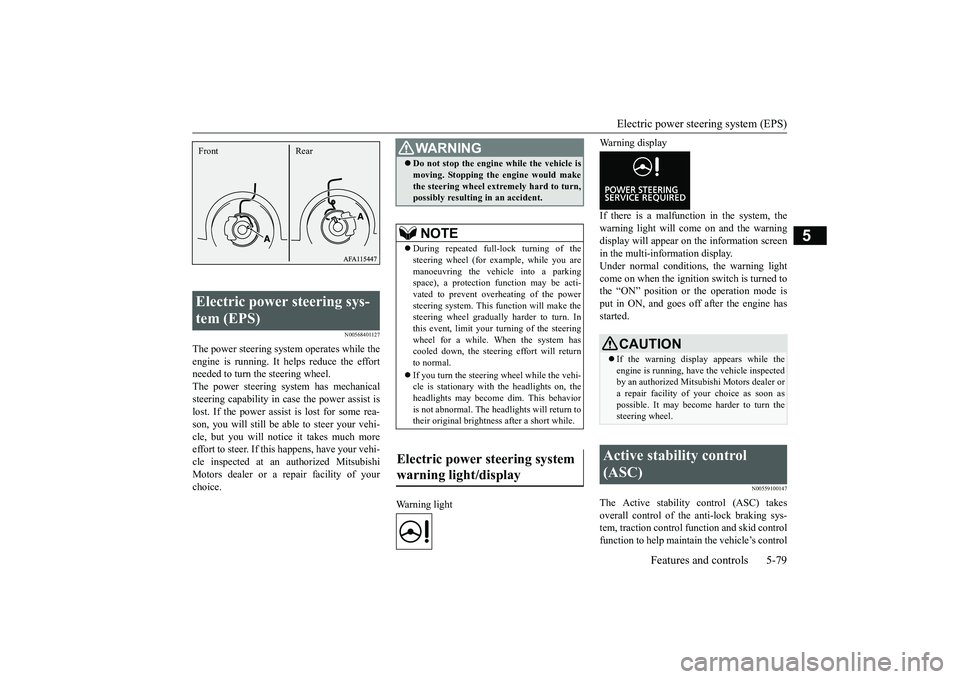
Electric power steering system (EPS)
Features and controls 5-79
5
N00568401127
The power steering system operates while the engine is running. It helps reduce the effort needed to turn the steering wheel. The power steering system has mechanicalsteering capability in case the power assist islost. If the power assist is lost for some rea- son, you will still be able to steer your vehi- cle, but you will notice it takes much moreeffort to steer. If this happens, have your vehi- cle inspected at an authorized Mitsubishi Motors dealer or a repair facility of yourchoice.
Warning light
Warning display If there is a malfunction in the system, the warning light will come on and the warningdisplay will appear on the information screen in the multi-information display. Under normal conditions, the warning lightcome on when the ignition switch is turned tothe “ON” position or the operation mode is put in ON, and goes off after the engine has started.
N00559100147
The Active stability control (ASC) takesoverall control of the anti-lock braking sys- tem, traction control function and skid control function to help maintain the vehicle’s control
Electric power steering sys- tem (EPS) Front Rear
WA R N I N G Do not stop the engine while the vehicle is moving. Stopping the engine would make the steering wheel extremely hard to turn, possibly resulting in an accident.NOTE
During repeated full-lock turning of the steering wheel (for example, while you are manoeuvring the vehicle into a parking space), a protection function may be acti-vated to prevent overheating of the power steering system. This function will make the steering wheel gradually harder to turn. Inthis event, limit your tu
rning of the steering
wheel for a while. When the system has cooled down, the steering effort will returnto normal. If you turn the steering wheel while the vehi- cle is stationary with the headlights on, the headlights may become dim. This behavior is not abnormal. The headlights will return totheir original brightness after a short while.
Electric power steering system warning light/display
CAUTION If the warning display appears while the engine is running, have the vehicle inspected by an authorized Mitsubishi Motors dealer ora repair facility of your choice as soon as possible. It may become harder to turn the steering wheel.
Active stability control (ASC)
BK0266800US.bo
ok 79 ページ 2018年6月27日 水曜日 午後5時6分
Page 170 of 423
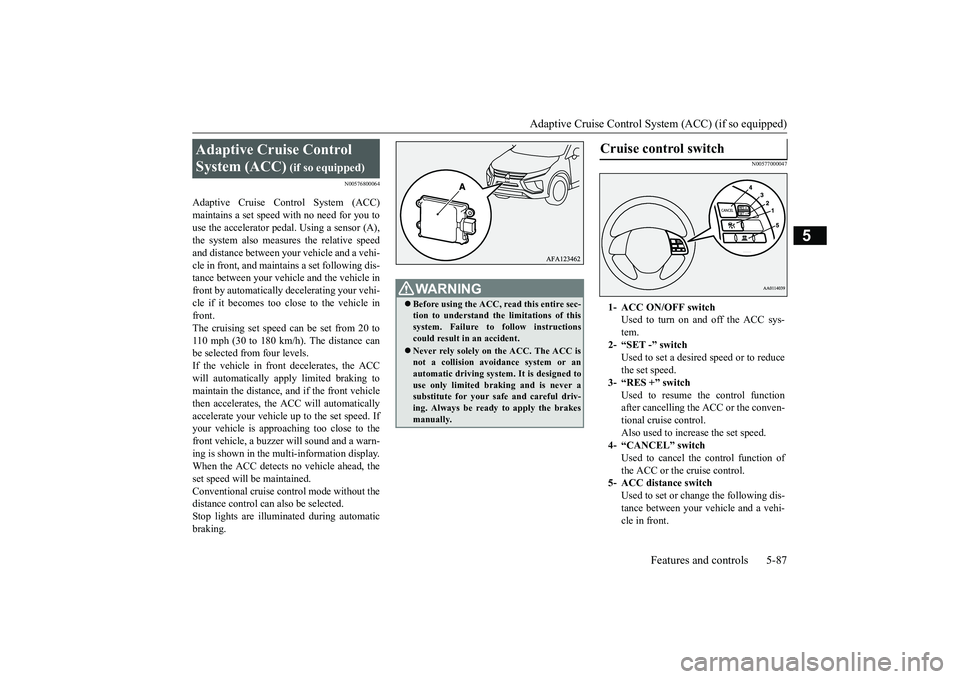
Adaptive Cruise Control System (ACC) (if so equipped)
Features and controls 5-87
5
N00576800064
Adaptive Cruise Control System (ACC) maintains a set speed with no need for you to use the accelerator pedal. Using a sensor (A), the system also measures the relative speedand distance between your vehicle and a vehi- cle in front, and maintains a set following dis- tance between your vehicle and the vehicle infront by automatically decelerating your vehi-cle if it becomes too close to the vehicle in front. The cruising set speed can be set from 20 to110 mph (30 to 180 km/h). The distance can be selected from four levels. If the vehicle in front decelerates, the ACCwill automatically apply limited braking to maintain the distance, and if the front vehicle then accelerates, the ACC will automaticallyaccelerate your vehicle up to the set speed. If your vehicle is approaching too close to the front vehicle, a buzzer will sound and a warn-ing is shown in the multi-information display. When the ACC detects no vehicle ahead, the set speed will be maintained.Conventional cruise control mode without the distance control can also be selected. Stop lights are illuminated during automaticbraking.
N00577000047
Adaptive Cruise Control System (ACC)
(if so equipped)
WA R N I N G Before using the ACC, read this entire sec- tion to understand the limitations of this system. Failure to follow instructions could result in an accident. Never rely solely on the ACC. The ACC is not a collision avoidance system or anautomatic driving system. It is designed to use only limited braking and is never a substitute for your safe and careful driv-ing. Always be ready to apply the brakes manually.
Cruise control switch
1- ACC ON/OFF switch
Used to turn on and off the ACC sys- tem.
2- “SET -” switch
Used to set a desired speed or to reduce the set speed.
3- “RES +” switch
Used to resume the control function after cancelling the ACC or the conven- tional cruise control.Also used to increase the set speed.
4- “CANCEL” switch
Used to cancel the control function ofthe ACC or the cruise control.
5- ACC distance switch
Used to set or change the following dis-tance between your vehicle and a vehi- cle in front.
BK0266800US.bo
ok 87 ページ 2018年6月27日 水曜日 午後5時6分
Page 174 of 423

Adaptive Cruise Control System (ACC) (if so equipped)
Features and controls 5-91
5
When the ACC no longer detects a vehicle in front, the buzzer will sound, the vehicle sym- bol in the display will disappear and your vehicle will slowly accelerate to the setspeed.
N00576900052
While the ACC is activat
ed, if your vehicle is
approaching too closely to the vehicle infront, the ACC gives a warning by sounding a buzzer and displaying a message. Apply the brakes to maintain the appropriate distance tothe vehicle in front.
WA R N I N G Never leave your vehicle while the ACC system is in the stationary vehicle hold state. When leaving the vehicle, apply the parking brake and move the selector leverto the “P” (PARK) position.NOTE
When the ACC system is in the stationary vehicle hold state, the stop lights will illumi-nate. While the ACC system is in the stationary vehicle hold state, the vehicle will not start moving again unless you press the “RES+” switch or depress the accelerator pedal. When depressing the brake pedal while the automatic brake is applied, the brake pedalwill feel firm. This is normal. Depress the brake pedal harder to apply greater braking force. During the automatic braking, operation sounds may be heard. This is normal. If the turn-signal lever is operated while the ACC is active, the system may accelerate the vehicle to assist you in passing a vehicle in front.
If the vehicle in front starts moving within 2 seconds after stopping, your vehicle will start moving.WA R N I N G Your vehicle may accelerate up to the set speed in the following situations. Apply the brake, if necessary, to slow down.• When your vehicle no longer follows thevehicle in front, e.g. at a freeway exit or when your vehicle or the vehicle in frontchanges its lane.NOTE
• When driving on a curve. When the vehicle in front has changed its course or lane, if a stationary vehicle appears in front your vehicle, the ACC will not decelerate your vehicle.
Approach alarm
WA R N I N G
BK0266800US.bo
ok 91 ページ 2018年6月27日 水曜日 午後5時6分
Page 182 of 423
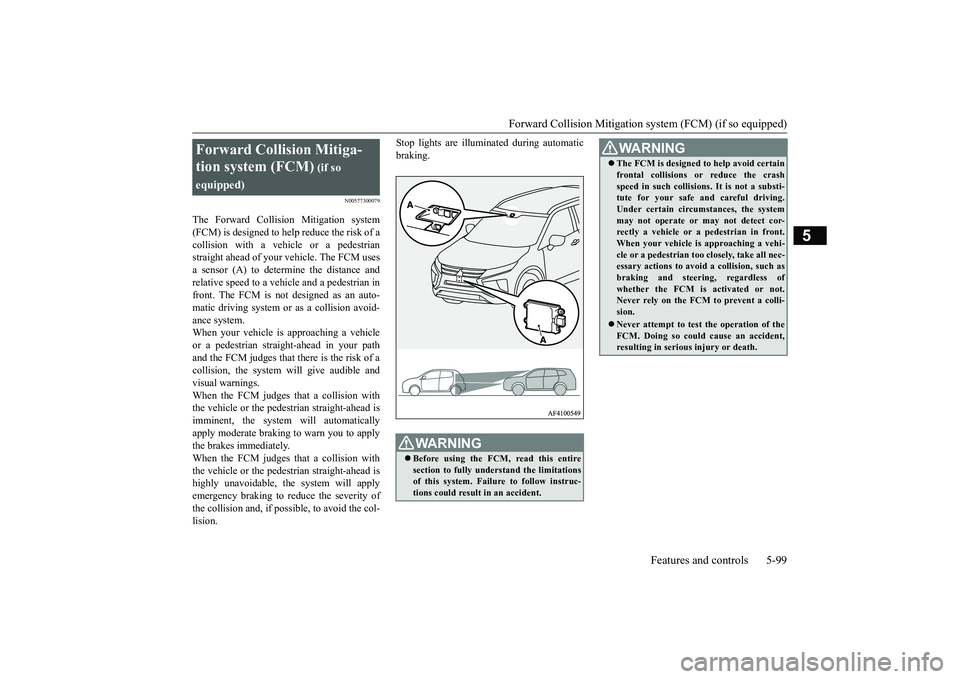
Forward Collision Mitigation sy
stem (FCM) (if so equipped) Features and controls 5-99
5
N00577300079
The Forward Collision Mitigation system (FCM) is designed to help reduce the risk of a collision with a vehicle or a pedestrian straight ahead of your vehicle. The FCM usesa sensor (A) to determine the distance andrelative speed to a vehicle and a pedestrian in front. The FCM is not designed as an auto- matic driving system or
as a collision avoid-
ance system. When your vehicle is approaching a vehicle or a pedestrian straight-ahead in your pathand the FCM judges that there is the risk of a collision, the system will give audible and visual warnings.When the FCM judges that a collision with the vehicle or the pedestrian straight-ahead is imminent, the system will automaticallyapply moderate braking to warn you to apply the brakes immediately. When the FCM judges that a collision withthe vehicle or the pedestrian straight-ahead is highly unavoidable, the system will apply emergency braking to reduce the severity ofthe collision and, if possible, to avoid the col- lision.
Stop lights are illuminated during automatic braking.
Forward Collision Mitiga- tion system (FCM)
(if so
equipped)
WA R N I N G Before using the FCM, read this entire section to fully understand the limitationsof this system. Failur
e to follow instruc-
tions could result in an accident.
The FCM is designed to help avoid certain frontal collisions or reduce the crash speed in such collisions. It is not a substi- tute for your safe and careful driving. Under certain circumstances, the systemmay not operate or may not detect cor- rectly a vehicle or a pedestrian in front. When your vehicle is approaching a vehi-cle or a pedestrian too closely, take all nec- essary actions to avoid a collision, such as braking and steering, regardless ofwhether the FCM is activated or not. Never rely on the FCM to prevent a colli- sion. Never attempt to test the operation of the FCM. Doing so could cause an accident,resulting in serious injury or death.WA R N I N G
BK0266800US.bo
ok 99 ページ 2018年6月27日 水曜日 午後5時6分
Page 184 of 423
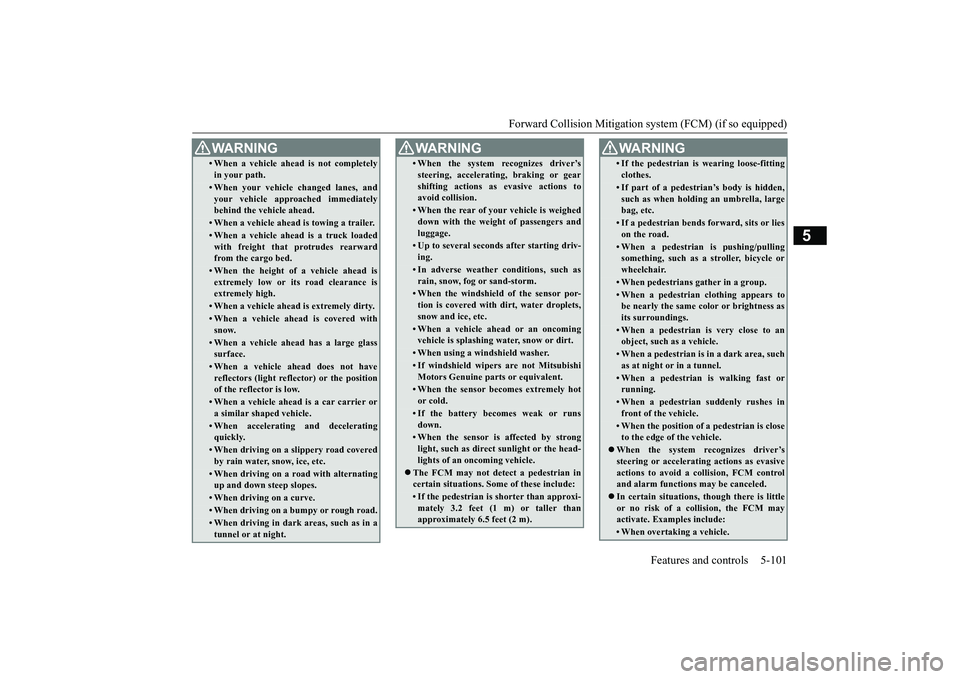
Forward Collision Mitigation sy
stem (FCM) (if so equipped) Features and controls 5-101
5
• When a vehicle ahead is not completely in your path.• When your vehicle changed lanes, and your vehicle approached immediatelybehind the vehicle ahead.• When a vehicle ahead is towing a trailer.• When a vehicle ahead is a truck loadedwith freight that protrudes rearwardfrom the cargo bed.• When the height of a vehicle ahead isextremely low or its road clearance is extremely high.• When a vehicle ahead is extremely dirty.• When a vehicle ahead is covered with snow.• When a vehicle ahead has a large glasssurface.• When a vehicle ahead does not havereflectors (light reflector) or the position of the reflector is low.• When a vehicle ahead is a car carrier ora similar shaped vehicle.• When accelerating and deceleratingquickly.• When driving on a slippery road coveredby rain water, snow, ice, etc.• When driving on a road with alternating up and down steep slopes.• When driving on a curve.• When driving on a bumpy or rough road.• When driving in dark areas, such as in atunnel or at night.WA R N I N G
• When the system recognizes driver’s steering, accelerating, braking or gear shifting actions as evasive actions to avoid collision.• When the rear of your vehicle is weigheddown with the weight of passengers and luggage.• Up to several seconds after starting driv-ing.• In adverse weather conditions, such asrain, snow, fog or sand-storm.• When the windshield of the sensor por-tion is covered with dirt, water droplets,snow and ice, etc.• When a vehicle ahead or an oncomingvehicle is splashing water, snow or dirt. • When using a windshield washer.• If windshield wipers are not MitsubishiMotors Genuine parts or equivalent. • When the sensor becomes extremely hotor cold.• If the battery becomes weak or runsdown.• When the sensor is affected by stronglight, such as direct sunlight or the head-lights of an oncoming vehicle.
The FCM may not detect a pedestrian in certain situations. Some of these include:• If the pedestrian is shorter than approxi-mately 3.2 feet (1 m) or taller than approximately 6.5 feet (2 m).WA R N I N G
• If the pedestrian is wearing loose-fitting clothes.• If part of a pedestrian’s body is hidden, such as when holding an umbrella, largebag, etc.• If a pedestrian bends forward, sits or lieson the road.• When a pedestrian is pushing/pullingsomething, such as a stroller, bicycle or wheelchair.• When pedestrians gather in a group.• When a pedestrian clothing appears to be nearly the same color or brightness as its surroundings.• When a pedestrian is very close to anobject, such as a vehicle.• When a pedestrian is in a dark area, suchas at night or in a tunnel.• When a pedestrian is walking fast orrunning.• When a pedestrian suddenly rushes infront of the vehicle.• When the position of a pedestrian is closeto the edge of the vehicle.
When the system recognizes driver’s steering or accelerating actions as evasive actions to avoid a collision, FCM control and alarm functions may be canceled. In certain situations, though there is little or no risk of a collision, the FCM may activate. Examples include: • When overtaking a vehicle.WA R N I N G
BK0266800US.book
101 ページ 2018年6月27日 水曜日 午後5時6分
Page 193 of 423
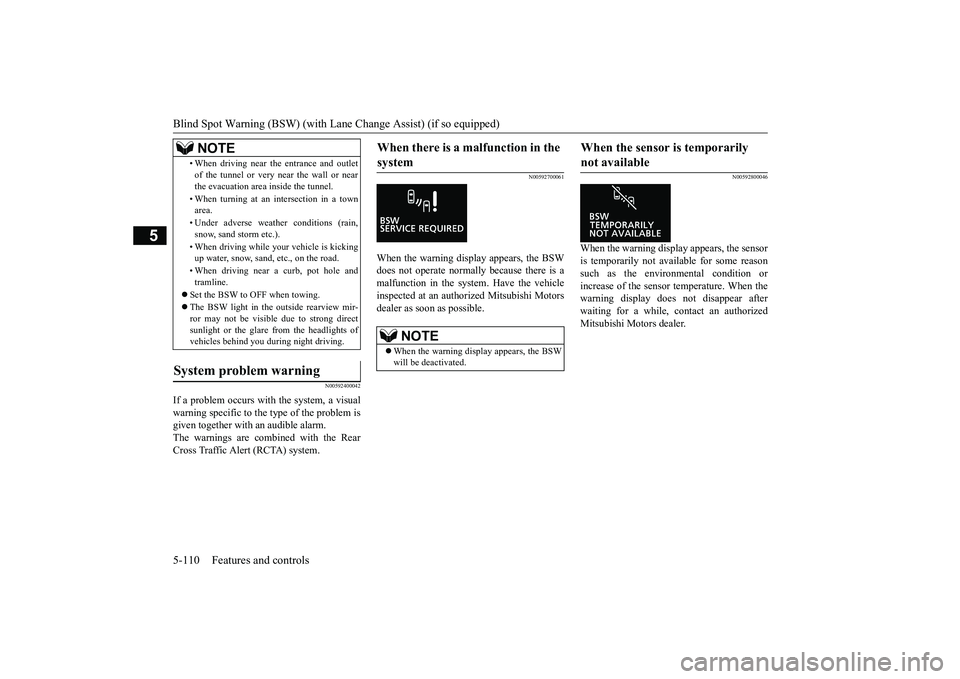
Blind Spot Warning (BSW) (with Lane
Change Assist) (if so equipped)
5-110 Features and controls
5
N00592400042
If a problem occurs with the system, a visual warning specific to the type of the problem is given together with an audible alarm. The warnings are combined with the RearCross Traffic Alert (RCTA) system.
N00592700061
When the warning display appears, the BSW does not operate normally because there is a malfunction in the system. Have the vehicleinspected at an authorized Mitsubishi Motorsdealer as soon as possible.
N00592800046
When the warning display appears, the sensoris temporarily not available for some reasonsuch as the environmental condition orincrease of the sensor temperature. When the warning display does not disappear after waiting for a while, contact an authorizedMitsubishi Motors dealer.
• When driving near the entrance and outlet of the tunnel or very near the wall or near the evacuation area inside the tunnel. • When turning at an
intersection in a town
area. • Under adverse weather conditions (rain, snow, sand storm etc.). • When driving while your vehicle is kicking up water, snow, sand, etc., on the road. • When driving near a curb, pot hole and tramline.
Set the BSW to OFF when towing. The BSW light in the outside rearview mir- ror may not be visible due to strong directsunlight or the glare from the headlights of vehicles behind you during night driving.
System problem warning
NOTE
When there is a malfunction in the system
NOTE
When the warning display appears, the BSW will be deactivated.
When the sensor is temporarily not available
BK0266800US.book
110 ページ 2018年6月27日 水曜日 午後5時6分
Page 196 of 423
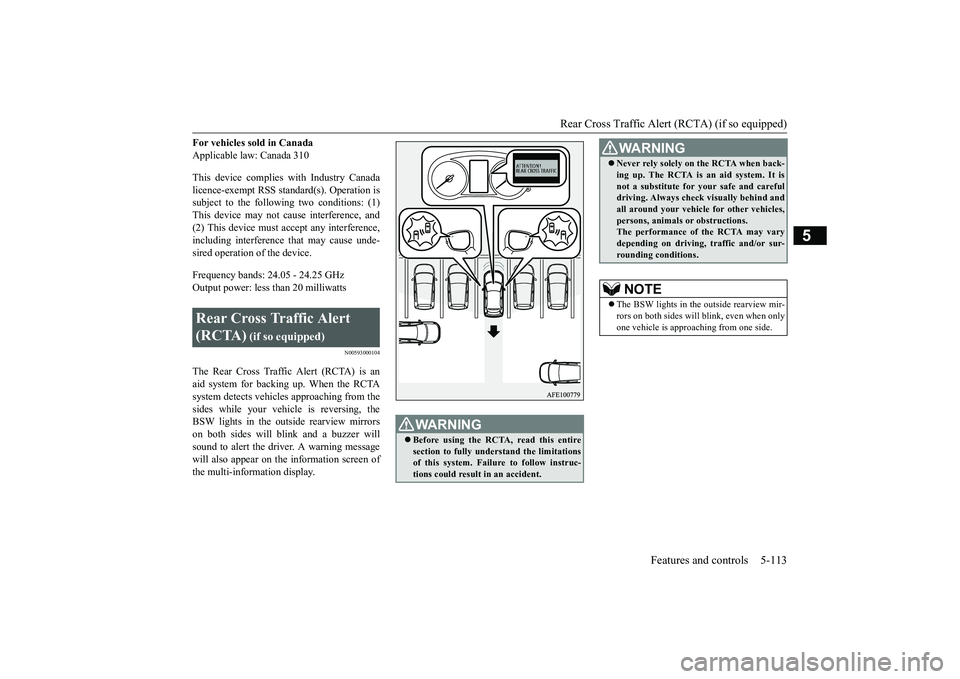
Rear Cross Traffic Alert (RCTA) (if so equipped)
Features and controls 5-113
5
For vehicles sold in Canada Applicable law: Canada 310 This device complies with Industry Canada licence-exempt RSS standard(s). Operation is subject to the following two conditions: (1)This device may not cause interference, and (2) This device must accept any interference, including interference that may cause unde-sired operation of the device. Frequency bands: 24.05 - 24.25 GHz Output power: less than 20 milliwatts
N00593000104
The Rear Cross Traffic Alert (RCTA) is an aid system for backing up. When the RCTA system detects vehicles approaching from thesides while your vehicle is reversing, the BSW lights in the outs
ide rearview mirrors
on both sides will blink and a buzzer willsound to alert the driver. A warning message will also appear on the information screen of the multi-information display.Rear Cross Traffic Alert (RCTA)
(if so equipped)
WA R N I N G Before using the RCTA, read this entire section to fully understand the limitationsof this system. Failur
e to follow instruc-
tions could result in an accident.
Never rely solely on the RCTA when back- ing up. The RCTA is an aid system. It is not a substitute for your safe and careful driving. Always check visually behind and all around your vehicle for other vehicles,persons, animals or obstructions. The performance of the RCTA may vary depending on driving, traffic and/or sur-rounding conditions.NOTE
The BSW lights in the outside rearview mir- rors on both sides will blink, even when only one vehicle is approaching from one side.WA R N I N G
BK0266800US.book
113 ページ 2018年6月27日 水曜日 午後5時6分
Page 197 of 423
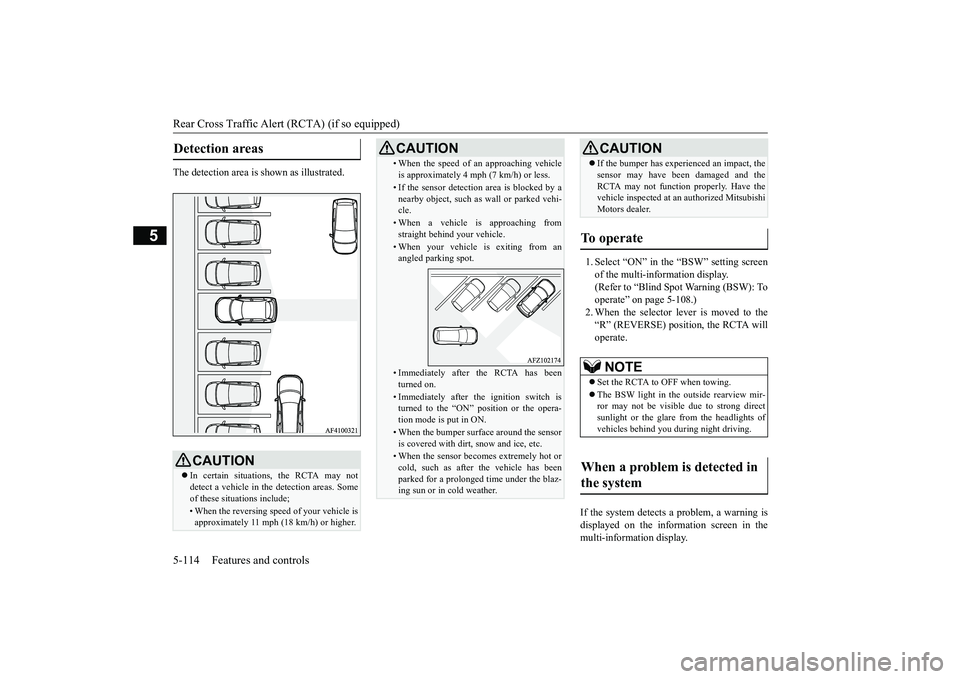
Rear Cross Traffic Alert (RCTA) (if so equipped) 5-114 Features and controls
5
The detection area is shown as illustrated.
1. Select “ON” in the “BSW” setting screen of the multi-information display.(Refer to “Blind Spot Warning (BSW): Tooperate” on page 5-108.) 2. When the selector lever is moved to the “R” (REVERSE) position, the RCTA willoperate.
If the system detects a problem, a warning is displayed on the information screen in themulti-information display.
Detection areas
CAUTION In certain situations, the RCTA may not detect a vehicle in the detection areas. Some of these situations include;• When the reversing speed of your vehicle is approximately 11 mph (18 km/h) or higher.
• When the speed of an approaching vehicle is approximately 4 mph (7 km/h) or less.• If the sensor detection area is blocked by a nearby object, such as wall or parked vehi-cle.• When a vehicle is approaching fromstraight behind your vehicle.• When your vehicle is exiting from anangled parking spot.• Immediately after the RCTA has beenturned on.• Immediately after the ignition switch isturned to the “ON” position or the opera- tion mode is put in ON.• When the bumper surface around the sensoris covered with dirt, snow and ice, etc.• When the sensor becomes extremely hot orcold, such as after the vehicle has been parked for a prolonged time under the blaz- ing sun or in cold weather.CAUTION
If the bumper has experienced an impact, the sensor may have been damaged and the RCTA may not function properly. Have the vehicle inspected at an authorized Mitsubishi Motors dealer.
To operate
NOTE
Set the RCTA to OFF when towing. The BSW light in the outside rearview mir- ror may not be visible due to strong directsunlight or the glare from the headlights of vehicles behind you during night driving.
When a problem is detected in the system
CAUTION
BK0266800US.book
114 ページ 2018年6月27日 水曜日 午後5時6分